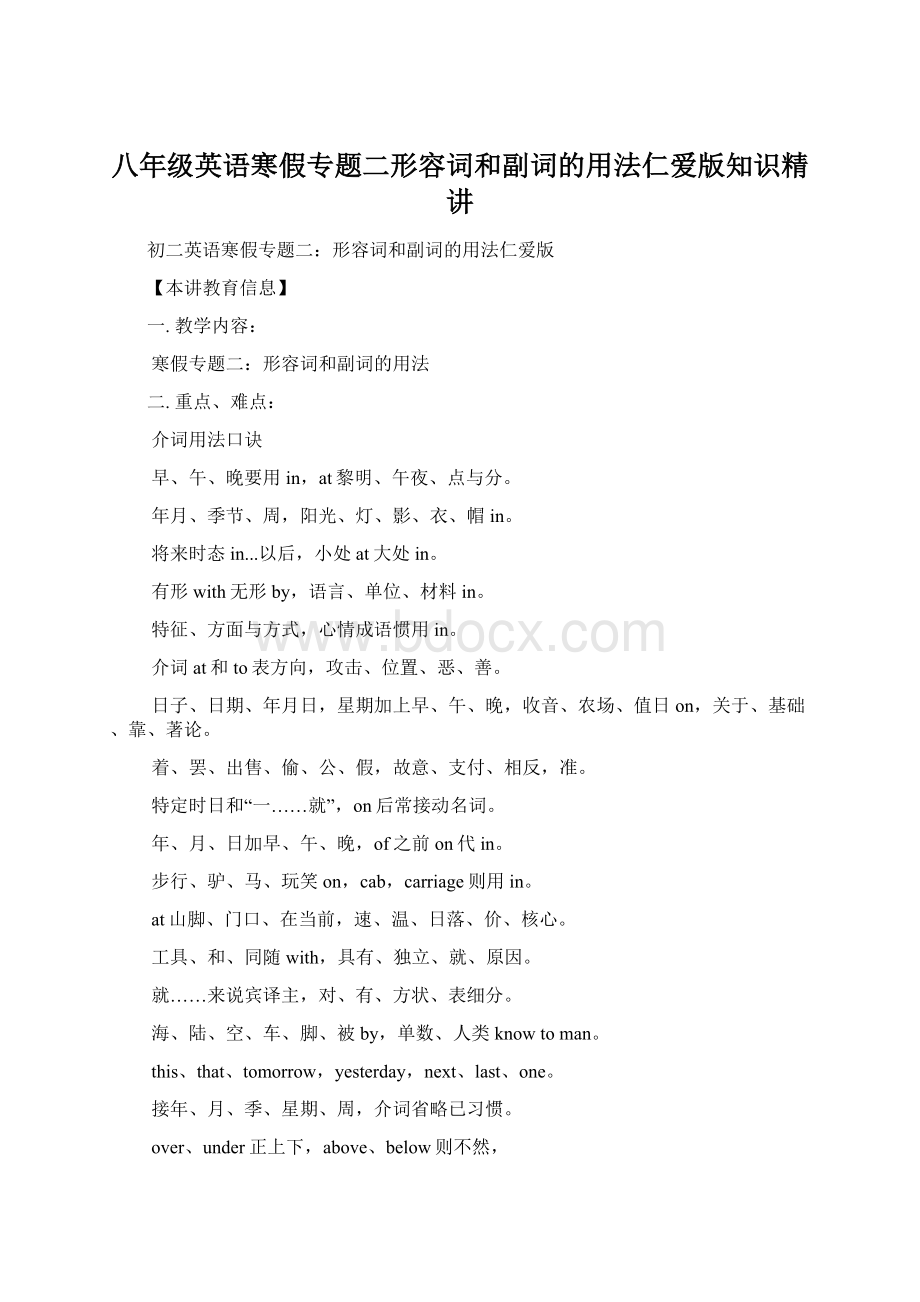八年级英语寒假专题二形容词和副词的用法仁爱版知识精讲Word格式.docx
《八年级英语寒假专题二形容词和副词的用法仁爱版知识精讲Word格式.docx》由会员分享,可在线阅读,更多相关《八年级英语寒假专题二形容词和副词的用法仁爱版知识精讲Word格式.docx(20页珍藏版)》请在冰豆网上搜索。

before能接完成时,ago过去极有限。
since以来during间,since时态多变换。
与之相比beside,除了lastbutone。
复不定for、找、价、原,对、给、段、去、为、作、赞。
快到、对、向towards,工、学、军、城、北、上、南。
butfor否定用虚拟,复合介词待后言。
ing型由于鉴,除了除外与包含。
之后、关于、在……方面,有关介词须记全。
in内to外表位置,山、水、国界to在前。
三.具体内容:
(一)形容词
1.形容词可分为两大类:
描绘形容词和限定形容词。
描绘形容词是描写人或物的颜色、尺寸、形状、性质、状态等的形容词。
限定形容词用于限定被修饰词的数量、距离、所有关系等。
除了these和those外,形容词的单数与复数形式相同。
描绘形容词
beautiful,large,red,
interesting,colourful
important
限定形容词
基数词(one,two)序数词(first,second)
物主代词(my,your)指示代词(this,that,these)
数量词(few,many)冠词(a,an,the)
2.形容词的位置
修饰语一般应置于被修饰语之前,但当几个形容词修饰同一名词时,其排列顺序一般如下:
形容词性代词→
数量词→
描绘形容词
allboth
the,a(n)
this,that
first
one
性质
尺寸
形状
新旧
温度
颜色
国籍
材料
good
large
old
red
Chinese
iron
such
your,some,
many
second
two
fine
small
hot
blue
English
stone
Example:
thatstrongyoungChineseswimmer
注意:
形容词前有as,so,no,too,how等词时,不定冠词应置于形容词之后。
Sheistookindagirltorefuse.
在下列情况下,修饰语应置于被修饰的名词后:
(1)名词之后的数量词+名词+old,long,wide等。
aboysixyearsold,astreettwokilometerslong
(2)为了加强语气或音调美,将描绘形容词置于名词之后。
Hehadafacethinandworn.
(3)something,anything,everyone,anybody…+形容词。
There’snothingwrongwiththeelectriccooker.
(4)作定语用的分词或形容词短语
Thejudgehastalkedtoallthepeopleinvolved.所包含的(形式复杂的)
3.“数词+名词”构成的形容词
(1)数词+名词,如atwo-weektour,aten-pagereport等。
(2)数词+名词+形容词,如aseven-year-oldboy等。
(3)名词(无冠词)+基数词=the+序数词+名词,如
Unit6=theSixthUnit
(4)“数量词+复数名词”作主语,虽然是复数形式,但仍然用单数动词,作为一个单位来表示。
如果强调个别数,则须用复数动词。
Tenyearsisquitealongtimetohim.
TwomonthshavepassedsinceIlastheardfrommyparents.
(二)副词
1.副词的构成如下:
(1)本身就是副词,如very,now,there,quite等.
(2)有形容词后缀如-ly,如happily,carefully等。
(3)有些副词与形容词同形,如early,high,long,fast,hard等。
有些-ly结尾的词不是副词而是形容词,如manly,friendly,queenly(女王的
威严的,慷慨的)等。
2.副词的位置
(1)修饰形容词和副词时,须放在被修饰词之前,如:
Thesceneryaroundhereisverybeautiful.
(2)always,never,often,sometimes,usually等表示频率的副词在一般动词前,be动词后,有助动词时,在助动词和动词之间。
Heusuallygetsupearly,buthegotuplatetoday.
IhavenevermethimandIhopeIwillnevermeethim.
(3)有两个以上不同种类的副词作修饰语时,其顺序为地点(小地点+大地点)→状态→次数→时间(单位小的时间+单位大的时间)。
TheyarrivedinParissafelytheotherday.
(4)seldom,rarely,never等具有否定意义的频率副词置于句首时,助动词或be动词须放在主语的前面(也叫倒装句),如:
NeverdidIhearsuchafunnystory.=Ineverheardsuchafunnystory.
3.几个特殊副词的用法
(1)enough须置于所修饰的形容词和副词之后;
too须置于所修饰的形容词和副词之前。
ShespeaksEnglishwellenoughtobeaninterpreter译员,口译者
It’stoohotadaytowork.
但enough修饰名词时须置于名词之前。
Haveyougotenoughmoneyforthismicrowave(微波)oven(烤炉,烤箱)?
(2)too…(for…)+不定式(to),作“太……而不能”解;
enough+不定式,意思是“足够可以”,这一结构可转换成so…that结构。
Theboywasstilltooyoungtogotoschool.
→Hewassoyoungthathecouldnotgotoschool.
ThemanisrichenoughtobuyaRoll-Royce.
→HeissorichthathecanbuyaRoll-Royce.
(3)already用于肯定句,作“已经”解;
yet用于否定句,作“还”解,用于疑问句作“已经”解,still作“仍然”解。
Ihavealreadyseenthefilm.
Haveyouseenthefilmyet?
Istillpreferteatocoffee.
(4)随着only和also在句中位置的改变,句意和语气也会改变。
OnlyMr.Licametoseemetoday.
Mr.Licametoseeonlymetoday.
Mr.Licametoseemeonlytoday.
(三)形容词的比较等级
形容词比较等级的规则变化如下表:
构成法
原级
比较级
最高级
1、单音节词末尾加-er和-est
伟大的great
greater
greatest
2、单音节词如以-e结尾,只加-r和-st
brave勇敢的
fine好的
braver
finer
bravest
finest
3、闭音节单音节词如末尾只有一个辅音字母,须先双写这个辅音字母,再加-er和-est
big大的
hot热的
bigger
hotter
biggest
hottest
4、少数以-y,-er,-ow,-ble结构的双音节词,末尾加-er,和-est(以-y结尾的词,如-y前是辅音字母,则y变为i,再加-er和-est。
以-e结尾的词仍只加-r和-st)
happy快乐的
clever聪明的
narrow狭窄的
able能
happier
cleverer
narrower
abler
happiest
cleverest
narrowest
ablest
5、其它双音节和多音节词皆在前面加单词more和most.
difficult困难的
moredifficult
mostdifficult
(四)形容词比较等级部分不规则变化表
比较级
最高级
well
better
Best
bad
ill
worse
worst
much
more
Most
little
few
less
Least
far
farther
further
farthest
furthest
older
elder
oldest
eldest
late
latter
later
last
latest
(五)形容词、副词比较等级的基本用法
形容词与副词都有三个比较等级。
(1)原级常用于“as+原级+as”结构。
Helikesherasmuchashelikeshissister.
否定的原级用notas…as或notso…as,二者一般无甚区别。
Hedoesnotsmokesoheavilyashisbrother.
(2)比较级常用于“比较级+than”结构。
Heistallerthanme.
否定比较与否定原级一样,也用notas(so)…as…结构,也可用less…than结构.
ThiswordislessfrequentinBritishEnglishthaninAmericanEnglish.
(3)两个人或物比较时,定冠词the+比较级表示最高级。
Heisthetallerofthetwo.
(4)最高级常用于“the+最高级+比较范围”结构,比较范围为短语或从句。
Itisthebestpictureinthehall.
(5)含有否定词的比较级,如
①nolessthan=asmuch(ormany)as“不亚于”
notlessthan=atleast“至少”
②noless…than=as…as“和……一样”
notless+原级+than“至少不亚于”
③nomore…than=not…anymorethan“和……一样不……”
notmore…than=notso…as“不像……那样……”
④nomorethan=only“只不过”,言其少
notmorethan=atmost“不多于”,“至少”
(6)表示“几倍于”用twice(两倍),threetimes(三倍)+as…as,
Thisbookcoststwiceasmuchastheotherone.
(7)the+比较级……,the+比较级,意思是“越……就越”,如:
Theharderyouwork,themoreyouwilllearn.
(8)比较结构之前可用程度状语加以修饰,如as…as前可用almost,nearly,just(about),quite等词语修饰,如:
Johnisalmostastallashisfather.
(9)在morethan结构之前可用far,(so)verymuch,(quite)alot,agreatdeal,(just)abit,still,far等词语修饰,如:
HespeaksEnglishalotmorerapidlythanhedoesFrench.
(10)比较级+and+比较级,作“越来……越”解,如:
Thedaysaregettinglongerandlonger.
常用动词习惯用法:
1.allowsb..todosth..允许某人去做某事(后接动词不定式)
Myfatherallowedmetogooutforawalkafterfinishingmyhomework.
2.askedsb..(not)todosth..叫某人做某事(叫某人不要去做某事)
Myfatheraskedmetostudyhard.
Heaskedmenottoswimalone.
beaskedtodosth..被叫去做某事/被邀请去做某事
Iwasaskedtohaveadinnerwiththemyesterday.
3.beafraidtodosth..害怕做某事
Sheisafraidtoaskmequestions.
4.beafraidofdoingsth..害怕做某事
Iamafraidofgoingoutatnight.
5.beafraidofsth..害怕某物
Heisafraidofsnakes.
6.beamazedtodosth..对做某事感到惊讶
Hewasamazedtomeetthegirlthere.
beamazedatsth..对某事感到惊讶
Theywereamazedatthenews.
7.bebusydoing/withsth..忙于做某事(常考)
Iwasbusywashingmycaratthattime.那时候我正忙于清洗我的车子。
Iambusywithmywork.
8.becoming/going/leaving/flying/moving/dying(某些位移动词用进行时态时表将来)
Thebusiscoming./Thedogisdying.
9.beexcitedtodosth..对做……感到兴奋
Jackywasexcitedtotraveltherebyplane.
beexcitedatsth..
Lilywasexcitedathiswords.
beexcitedaboutdoingsth..
Hewasexcitedaboutpassingtheexamwithoutgoingoverbooks.
10.befrightenedtodosth..害怕去做某事
Samisfrightenedtorideahorse.
11.beglad/happytodosth..高兴去做某事
Sheishappytocleantheblackboardwithme.
bepleasedtodosth..高兴做某事
Shewaspleasedtohelptheoldmanyesterday.
bepleasedwithsth..对某事感到高兴/满意
Theteacherwaspleasedwithmyanswer.
12.beinterestedinsth../doingsth..对某事感兴趣/对做某事感兴趣
Sheisinterestedinswimmingintheriver.
MybrotherisinterestedinChinese.
13.be/getreadyfor/todosth..
bereadyforsth..为某事做好了准备
Wearereadyfortheexam.
bereadytodosth..为做某事做好了准备
Wearereadytohaveabirthdaypartyforher.
getreadyforsth..为某事在做准备
Wearegettingreadyfortheexam.
getreadyforsth..为做某事而做准备
14.besorrytodosth..对做某事感到抱歉
15.besurprisedtodosth..对做某事感到惊奇
besurprisedatsth..对某事感到惊奇
16.beworthdoingsth..值得做某事(worth后接动词-ing形式,常考)
18.can/beabletoafford(tobuy)sth..有能力购买(供)……
19.can/may/mustdosth.could/would/should/mightdosth.
20.can’twaittodosth.迫不急待地去做某事
21.decidetodosth.决定去做某事
makeupone’smindtodosth.下决心去做某事(常考)
makeadecisiontodosth.对做某事作出决定
22.deservetodosth.值得/应该做……
23.encouragesb.todosth.鼓励某人去做某事
24.enjoydoingsth.乐意去做某事
25.expect(sb.)todosth.期望某人去做某事
26.failtodosth.做某事失败
succeeddoingsth.成功做了某事
27.finishdoingsth.做完某事(后接动词-ing形式)(常考)
28.followsb.todosth.跟随某人去做某事
30.get/haveachancetodosth.得到一个做某事的机会
31.give/pass/show/lend/sellsb.sth./sth.tosb.
buy/get/bringsb.sth./sth.forsb.
32.goontodosth.继续做事(常考)
goondoingsth.继续做事(常考)
33.hatetodo/doingsth.讨厌/不喜欢做某事
34.havefundoingsth.喜欢做某事
35.haveproblemsdoingsth.做某事遇到困难
36.havesb.dosth.让某人做某事(后接动词原形)
havesth.done让某事完成
havesth.todo有事要做
37.hearsb.dosth.听到某人做某事(后接动词原形,常考)
hearsb.doingsth.听到某人正在做某事(常见)
38.helptodosth.帮忙做某事
helpsb.(to)dosth.帮助某人做某事
39.hope/wishtodosth.希望做某事
wishsb.todosth.希望某人做某事
40.Itseemsthat这像是……(后接从句)
seemtodosth.
seem+adj
41.It’s+adj+(forsb.)todosth..
It’s+adj+(ofsb.)todosth.
It’sgladforhimtohearthenews.
42.Ittakessb.sometime/moneytodosth..花费某人多长时间做某事(常考)
43.pay…for…costspend…on…ittake…todosth.
44.It’sbestforsb.todosth..对某人来说做某事是最好的
hadbetterdosth.最好做某事(注意had没有时态和人称的变化,better后接动词原形)
45.It’stimeforsb.todosth.是某人做某事的时候了
46.keep(on)doingsth.坚持做某事(常考)
keepsb.doingsth.让某人做某事(常考)
keepsb.fromdoingsth.阻止某人做某事(常考)
keepsb./sth.+ad